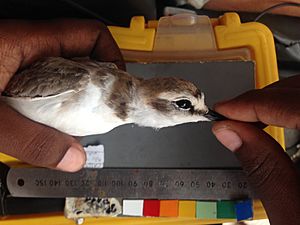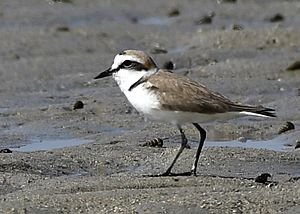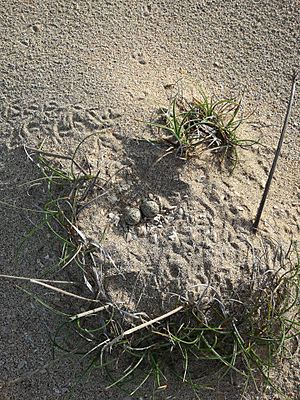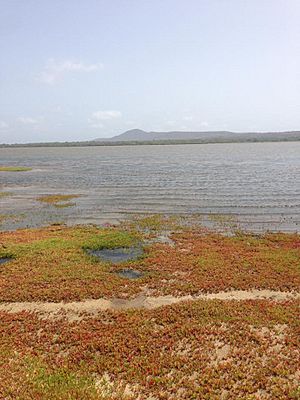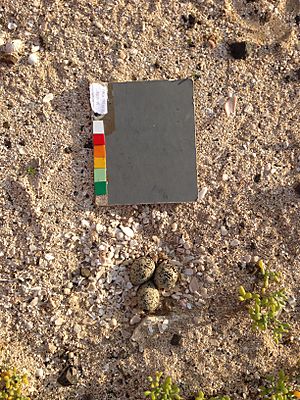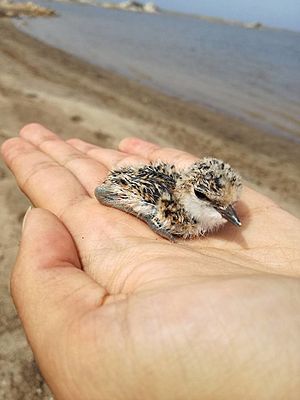Kentish plover facts for kids
The Kentish plover (Charadrius alexandrinus) is a small bird that lives near water all over the world. It belongs to the Charadriidae family. These birds weigh about 40-44 grams. They like to breed on the shores of salty lakes, lagoons, and coasts. You can find them in sand dunes, marshes, dry deserts, and even cold tundra areas.
Both male and female Kentish plovers have light-colored feathers. They have a white belly, a grey or brown back, dark legs, and a dark bill. However, male birds also have dark, incomplete bands across their chest and dark marks on the sides of their heads. This means the male and female birds look different, which is called being sexually dimorphic.
The Kentish plover lives in many places, from North Africa (like Senegal and the Cape Verde islands) to Central Asia (like salty lakes in China) and Europe (including small groups in Spain and Austria). Some groups of these birds migrate, flying to Africa for the winter. Other groups, especially those on islands, stay in one place all year. The bird's common English name comes from Kent, a county in England, where it used to live. However, it hasn't nested in Britain since 1979.
Kentish plovers build their nests on the ground. They often choose low, open, and moist spots away from thick plants and people. They use things like shells, small stones, grass, and leaves to build their nests in a small dip in the ground. Like most plovers, they mainly eat insects. They hunt for many different arthropods and invertebrates depending on where they live. They use a "run and stop" method to catch their food.
Quick facts for kids Kentish plover |
|
|---|---|
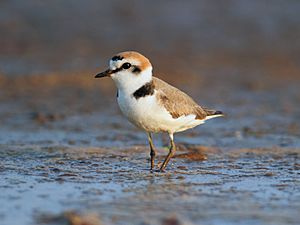 |
|
| Male in breeding plumage, India | |
| Conservation status | |
| Scientific classification | |
| Genus: |
Charadrius
|
| Species: |
alexandrinus
|
| Subspecies | |
|
|
 |
|
| Range of Ch. alexandrinus Breeding Resident Non-breeding Vagrant (seasonality uncertain) | |
| Synonyms | |
|
|
Contents
Understanding Their Family
The way scientists classify the Kentish plover has changed over time.
For many years, scientists thought the Kentish plover and the North American snowy plover were the same species. But in 2009, new genetic research showed they were actually different. In 2011, important bird groups like the International Ornithological Congress (IOC) agreed. They officially named the snowy plover as its own species, Charadrius nivosus.
Another bird, the white-faced plover (Charadrius dealbatus), was also separated from the Kentish plover. There was even talk about splitting off another type, the Hanuman plover.
The Hanuman Plover
The subspecies Charadrius alexandrinus seebohmi was recently recognized as its own species, the Hanuman Plover, in 2023. It was named after a chain of islands in the Palk Strait. These islands are said to have been built by Hanuman, a monkey god in Hinduism.
What They Look Like
The Kentish plover is a small shorebird, weighing about 40 grams when it's grown up. Both male and female birds have black bills and dark legs. However, adult males and females have different feather patterns, especially during the breeding season.
During the time they are breeding, male plovers have a black bar on their head. They also have two dark, incomplete bands on each side of their chest, black patches near their ears, and reddish-brown feathers on their neck and top of their head. Female plovers are lighter in these areas and do not have these dark markings. It's easy to tell males and females apart early in the breeding season because the males' fancy feathers are very clear. But as the season goes on, the differences become less noticeable.
Males also have longer legs and longer feathers on their sides than females. These longer side feathers are thought to help them keep their eggs warm during incubation and care for their young.
Where They Live and Travel
Their Homes Across the World
Kentish plovers live in many different places. Their homes can be very different, from hot deserts where the ground reaches 50°C to cold tundra areas. They breed in Europe, Asia, and Africa. In Europe, they are usually found in the west. In Africa, they live on the southern coast of Senegal and along the northern coast of the Mediterranean Sea and the Red Sea. Their breeding areas also stretch along the Arabian Peninsula, including Saudi Arabia, Qatar, and Bahrain.
You can also find small groups on islands like the Cape Verde archipelago, the Canary Islands, and the Azores. They are rarely seen in Australia. Some groups of plovers, like those on Maio in Cape Verde, do not migrate. But other groups can fly long distances. For example, plovers that spend winter in North Africa have been known to fly to Turkey and Greece in the spring.
Where They Live and How They Move
Kentish plovers most often breed on the shores of salty lakes, in wetlands, salt marshes, and along coasts. Studies show that they prefer to nest in low areas with little plant growth, lots of moisture, and far away from people.
Sometimes, parent plovers move their chicks from places with little food to places with more food. The chicks then grow stronger in these new areas. This shows that parents carefully choose where to move their young. Moving young can help protect them from predators, find more food, and avoid fighting with other birds for space. However, moving takes a lot of energy, especially for young birds. It can also increase the risk of being caught by a predator while moving through open areas. But overall, moving to a place with more food helps chicks grow and survive, which means the parents have more success raising their young.
How They Live and Behave
Reproduction and Life Cycle
Kentish plovers have a very flexible way of breeding. Some pairs stay together for life (monogamous), while others have multiple partners (polygamous). Breeding pairs sometimes return to the same partner the next year. However, they can also change partners during the same breeding season or between seasons.
The breeding season for Kentish plovers usually lasts between 2 and 5 months. The exact time of year depends on where the birds live. If a nest fails, pairs can lay new eggs more than once in a season, sometimes with the same partner or a new one. Both males and females can raise more than one group of chicks in a season.
Their courtship displays, which are how they try to attract a mate, also differ. In groups where birds have multiple partners, males and females spend much more time courting than in groups where they stay with one partner. Courtship displays include running flat on the ground, making small dips in the ground for nests, and fighting to protect their breeding area (mostly done by males).
Their Territories
Kentish plovers live in sandy areas or salt marshes close to water. Inland, you might find them near salty lakes, ponds, or reservoirs. Along the coast, they live on bare beaches, near lagoons, or in sand dunes.
Kentish plovers are birds that protect their own space. The male usually has a territory and attracts females with his courtship displays. Both parents actively defend their nest areas from predators. They might chase, fight, or make threatening poses. If a predator gets too close to the nest, the plovers quickly run away from it. Then, they start doing "distraction displays" to get the predator's attention and lead it away from the nest. These displays include calling loudly or crawling on the ground while flapping their wings.
Males tend to be more aggressive than females. However, females sometimes take more risks when defending the nest. When a plover's territory is invaded, it might try to invade a neighbor's territory. This often leads to fights between males, especially when they feel their chicks are in danger. Sometimes, chicks can get hurt or even killed during these fights. When a predator approaches, young chicks usually try to hide, crouch down, and stay still to avoid being seen. Older chicks try to run away with their parents.
Nesting and Incubation
Kentish plovers either nest alone or in loose groups. They are ground-nesting birds, laying their eggs in small, shallow dips in the bare ground. The male prepares these dips during courtship. Choosing the right nesting spot is very important for the survival of the eggs and chicks. Nests are placed near water on bare ground or in thin plants. They are often on slightly raised spots so the birds can see predators from far away. Sometimes, nests are near small bushes or grass clumps, which help hide the eggs from predators.
Nests are filled with materials like small stones, pieces of shells, fish bones, tiny twigs, grass, and other bits of debris. Most nests have three eggs, but some might have one or two. In new nests, the eggs might be fully visible. But as the incubation time goes on, the birds add more nesting material, and the eggs become almost completely covered.
During incubation, the Kentish plover leaves the nest for short times, mainly to find food or do other things they need to survive. To make up for not being on the nest and to protect the eggs, they use nest materials to cover and hide the eggs. This also helps keep the eggs warm. Kentish plovers actively control how much nest material they use. If you add or remove material, they will put it back to the original amount within 24 hours. This is helpful because nest materials keep the eggs warm, preventing them from getting too cold and saving the parents' energy. By controlling the material, they balance keeping the eggs warm and safe from predators with preventing them from getting too hot.
Incubation is when the eggs are kept at the right temperature (between 37°C and 38°C) for the baby birds to grow. Most of the heat comes from the parent bird sitting on the eggs. Kentish plover eggs are incubated for 20–25 days by both parents. Females usually sit on the eggs during the day, while males sit at night. Female Kentish plovers often lose weight during the day, even though males take over sometimes. This weight loss is a cost of incubation, as they use up their fat stores and lose water.
Raising Their Young
How parents care for their young can be different among birds. Kentish plovers have a unique way compared to other shorebirds. Both parents incubate the eggs, but they don't always both stay with the chicks once they hatch. It's common for one parent to leave the chicks after a certain amount of time. This is called "brood desertion." Brood desertion means one or both parents stop caring for their young before the young can survive on their own. This usually happens about a week after the chicks hatch. Both males and females have been seen leaving the brood, but females leave much more often than males.
Studies show that both male and female Kentish plovers can take good care of their chicks by themselves. So, it's not that one parent is better at caring than the other. However, studies also show that females have a better chance of breeding again successfully after leaving the brood than males do. In short, both parents can care for the chicks equally well, but females gain more by leaving, which is why they do it more often. The parent who stays can continue to keep the chicks warm up to 80% of the time for over 20 days after hatching. This is important because young chicks are very vulnerable and easily affected by outside temperatures.
If a parent bird feels that its eggs or chicks are in danger, it will pretend to be hurt. This is to draw the predator's attention away from the nest and towards itself.
Their Calls
The alarm call of the Kentish plover sounds like "kittup." You can hear this call both on the ground and in the air. It can be heard alone or with a "tweet" sound, like "too-eet." Their threat call is described as a "twanging, metallic, dwee-dwee-dweedweedwee" sound.
What They Eat
Kentish plovers either look for food alone or in small groups of 20-30 birds (outside the breeding season). Sometimes, they join larger groups of up to 260 birds of different species. Their main food is tiny water and land invertebrates. This includes insects and their larvae (like beetles, grasshoppers, or flies), snails, crabs, spiders, and marine worms.
They hunt by sight and often feed along the shores of lakes, lagoons, or ponds in wet, muddy areas rich in invertebrates. They find food by looking, stopping or running, and then pecking to catch their prey. They also poke into the sand to search for food or catch flies by holding their mouths open. How well a Kentish plover finds food is affected by light, wind, and rain. At night, it might be harder for them to find prey. However, plovers have good night vision because of their large eyes and sensitive eyesight.
Their Status and Protection
How Many There Are
The Kentish plover is listed as "least concern" on the Red List. This means it has a very large population range and is not currently in danger of disappearing.
However, the total number of Kentish plovers around the world is slowly going down. For some groups, we don't know if their numbers are changing. The European population is estimated to be between 43,000 and 70,000 birds. This makes up about 15% of the global population, which is thought to be between 100,000 and 500,000 birds.
Dangers They Face
A big danger to these birds is losing their homes and being disturbed. Human activities like tourists walking through protected areas, pollution, taking too many resources, and building cities can destroy their nesting sites. Plover populations can also be harmed by people in rural areas, like fishermen walking through breeding sites with many dogs. Dogs are known predators of plover eggs. Breeding birds react much more strongly to people when dogs are around, because they see it as a greater danger.
Natural predators are also a problem. Many predators seem to do very well in plover breeding areas, like the brown-necked raven in Maio, Cape Verde, the White-tailed Mongoose in Saudi Arabia, and the Grey Monitors in Al-Wathba Wetland Reserve. It's thought that the large amount of prey available attracts these predators to the breeding grounds. This is sometimes called the "honey pot" effect.
Global warming and climate change also reduce the areas where plovers can breed and live. Kentish plovers prefer to build their nests on low land close to water. A study in Saudi Arabia found that 11% of nests were actually below sea level. This means that rising sea levels are expected to cause big problems for these low-lying nests.
How We Can Help
The Kentish plover is currently protected under Annex I of the EU Birds Directive and Annex II of the Bern Convention. To help protect this species, people are suggesting that we protect their natural homes. This means creating or improving protected areas where they breed. It's important to stop pollution, filling in land, and building cities in these areas. Human activity should also be controlled and kept to a minimum in these sensitive places.
See also
 In Spanish: Chorlitejo patinegro para niños
In Spanish: Chorlitejo patinegro para niños





